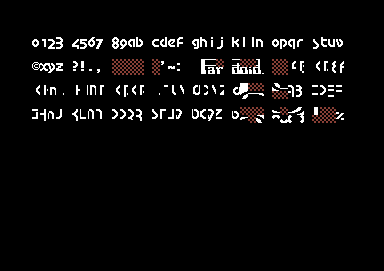 I keep surprising myself with all the memory I can squeeze out when I start trying. When reordering the multicolor charset from the Metal Edition Paradroid I finally took a good peek at the alpha charset. Eliminating duplicate chars and blanks freed another 31*8 bytes and couple more in graphics font. There are several 8-byte data areas I can scatter anywhere in the memory, but to keep it neater I should do some rearranging. Finding the correct data block in binary file whenever I want to change something doesn't sound fun to me.
I keep surprising myself with all the memory I can squeeze out when I start trying. When reordering the multicolor charset from the Metal Edition Paradroid I finally took a good peek at the alpha charset. Eliminating duplicate chars and blanks freed another 31*8 bytes and couple more in graphics font. There are several 8-byte data areas I can scatter anywhere in the memory, but to keep it neater I should do some rearranging. Finding the correct data block in binary file whenever I want to change something doesn't sound fun to me.
In case you're wondering about those five blank chars below "8" - "c" and why they aren't used... Chars $28-$2c (top halves of those 1*2 characters) are at offset $0140 and need 40 bytes. (Not so) interestingly that's the same offset and size as 10th character line on screen, which is the first line used for the deck display. To change all sprite pointers and displayed charset with single $d018 write I simply switch from blank screen + blank font to actual game screen and graphics at the correct line. However, VIC-II has already read the character pointers at that time (from blank screen) which means that I have to copy the top line from game screen into the blank screen. That in turn makes chars $28-$2c visible if used because the blank screen is actually the first half of the blank font... So, those chars are unusable as graphic data both in alpha font and in in-game graphics font. That however doesn't mean that they can't be used for anything else ;)
From graphics to sound effects... I found out that I can move the main SFX table partially into the RAM under I/O at a cost of ten cycles every time an effect is started. This filled up the hard-to-use $D000 RAM completely, and freed 160+ bytes elsewhere.
Back to graphics with something which is only an idea so far. Compressing droid parts separately would gain ~600 bytes, but I can do even better. If sprites are decompressed into one continuous block, I can use the previous sprite data as codebook which would give better compression at no extra cost. Extra time used for decompression isn't anything to worry about, no one has complained about the sprite mirroring delay yet and that one takes about 15,000 cycles per sprite, 60,000 cycles in total - even if mirrored sprites aren't used at all!
All these summed up give me more than one kilobyte to play with - but what should I fill it with?
1 comment:
Fill it with an Easter Eggs for now... :-) We will have to find it.
Post a Comment